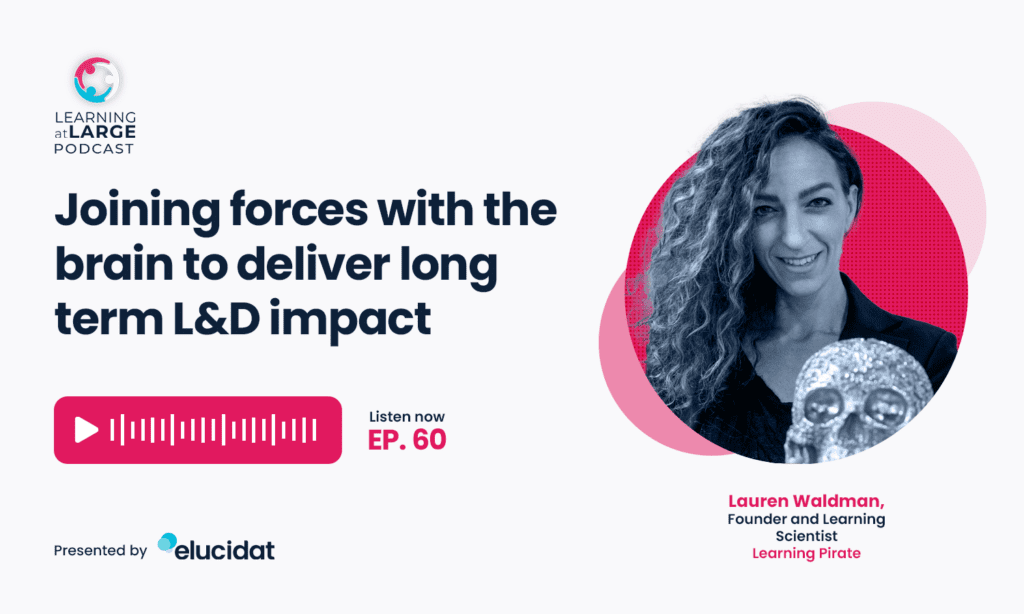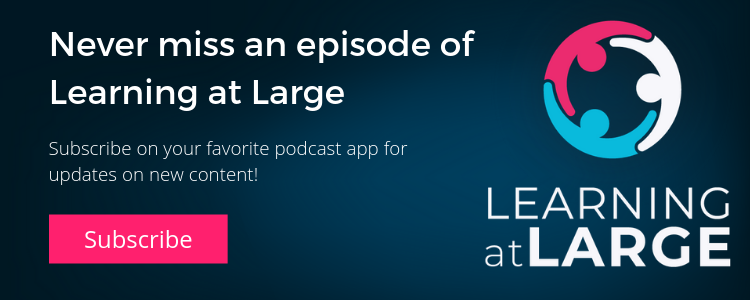Joining Forces With The Brain: Lauren Waldman
For too long learning has happened without consideration of the underlying mental processes it involves. The results? We’re all working against the brain, rather than with it. And this is something that Lauren Waldman, Founder and Learning Scientist behind Learning Pirate, has set out to change. Hear why she’s on a mission to get L&D to lead with the science. In fact, she thinks everyone should better understand their brain.

Top tips for designing learning with science in mind
Don’t have time to listen now? Here are some top tips from Lauren:
- Work with the brain, not against it: Start focusing on what’s going on in the brain, so you can design learning more scientifically.
- Embrace the complexity of creating memories: Forming memories is a complex and time-consuming process. Understand how it works so you can embed your learning.
- Cultivate habits based on science: Rote memorization won’t deliver impact. Swap old learning habits for new behaviors that work with your brain’s processes.
- Get the operating guide to being human: Understanding the brain science provides some fundamental human skills. Apply this knowledge and transform everything you do.
1. Work with the brain, not against it
Learning isn’t automatic. A lot is happening in your brain when you’re developing a new skill or adapting your behavior. However, because these processes are unconscious, it can be easy to take them for granted.
Whether it’s stretching a learner’s cognitive load or dividing their attention, L&D can often fall into the trap of working against the brain. Lauren is on a mission to change this. She wants L&D to start focusing on what’s going on in the brain so they can design learning more scientifically.
“Once you know these things, there’s absolutely no going back. You cannot see your learning designs in the same way anymore. You cannot see the way that you engage with your own learning, or a conversation with somebody, or the people who are walking by you on the street [in the same way]. Everything changes the more that you get to understand the operational system itself. So, I think the question isn’t, why should we be working with what we know about the brain? But why aren’t we working with what we know about the brain?”
2. Embrace the complexity of creating memories
When you design learning, you’re asking somebody else’s brain to engage in creating memories. We’ve been driven by psychology to think of this as a simple process, but neuroscience has revealed a different picture.
Creating memories isn’t straightforward. It’s a complex process and takes time. Understanding how it works is the key to designing effective learning that embeds new knowledge, skills and behavior. Lauren explains that without it you can’t identify the right learning methods to use, let alone when, where or how to use them.
“Creating a memory, in psychology, is the process of encoding, storing and retrieving. That makes it sound pretty simple, right? I learned something. I encode it, I store it, I get it in there and then I just bring it back out when I want it. It makes it sound like it can happen a lot faster than it does. Whereas in neuroscience, when you look into the brain, it might have to grow a whole new piece of brain network to do this. The brain is expending a lot of energy and requires a lot of dedicated focus to learn and to create that memory. You might not be allowing for that time if you just think: encode it.”
3. Cultivate habits based on science
Most of us continue to learn in the same way that we did when we were in elementary school. Go into any library and you’re likely to see students reading, highlighting and making notes. This rote memorization may help you pass an exam, but will it have any longer-term impact?
Lauren says it’s time to swap our old learning habits for new ones. We need to change our behaviors and cultivate habits based on the underlying mechanisms of the brain. For example, recognize how spaced repetition can consolidate our memories. Rather than designing a standalone piece of learning, break things up. Provide pauses so there’s time for learning to diffuse.
“The underlying mechanisms of the brain that help us to change a behavior or cultivate a habit, those are the things that we don’t teach. And those are the things that organizations are still expecting to see changes of. We want the behavioral change, but we’re not going to teach you how to do it. We’re not going to give you the fundamental human skills to help you do that. And that’s definitely an issue in our designs, and in our working environments.”
4. Get the operating guide to being human
Of course, this knowledge won’t just help you design effective learning. These are fundamental human skills. They empower you to change the way you see and approach the world around you.
Lauren explains that she created the Joining Forces With Your Brain learning journey so she had the operating guide to herself. For example, if she’s frustrated when someone is talking in a meeting that she doesn’t want to be in, she understands why. She knows what’s happening to create this behavioral reaction and can do something about it.
“When you learn about these things for yourself first, then you can transfer it into everything that you’re doing – into your learning, into your learning designs, into your better communications, into your projects, into all of it. We contextualize it in learning because that’s the profession that we’re in. But fundamentally, you’re learning about how you operate as a human being. And these are skills we can transfer anywhere.”
A quick recap
Tired of seeing learning that’s at odds with our underlying mental processes, Lauren has developed four strategies to make brain science central to L&D’s work.
- Join forces with the brain, rather than work against it.
- Get to grips with how memories are created so you can you design learning that sticks.
- Build better learning habits and behaviours that are grounded in science.
- Don’t just use this knowledge for better L&D. Apply these fundamental human skills in every area of your life.
Want to find out more? Check out the full podcast.
About Lauren
After 10 years in L&D, Lauren founded Learning Pirate in 2017 with the aim to search for learning treasure and venture into new territory for the industry. She’s passionate about helping organizations work better by designing learning more scientifically.
You can find out more at the Learning Pirate website and get connected with Lauren on LinkedIn.
Join the conversation!
We’d love to hear your thoughts on our podcast, so feel free to get in touch with our podcast host, at kirstie.greany@elucidat.com. As always, don’t forget to subscribe to Learning at Large in your favorite podcast app and leave us a 5-star rating if you enjoyed it. Thank you for joining us, and see you next time.
